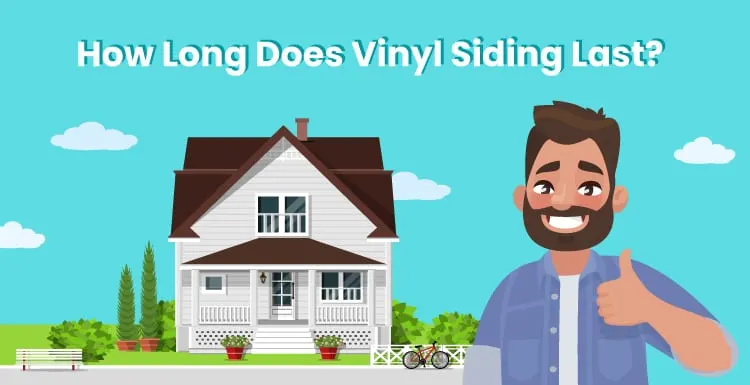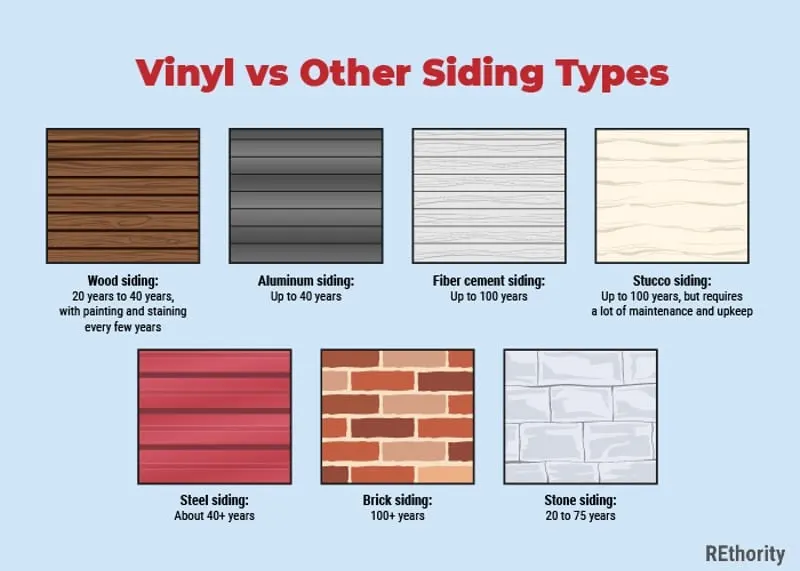Vinyl siding is one of the most popular siding choices available for a few reasons. It’s cheaper than options like wood and steel siding.
It is available in a wide range of color options and styles. You can even get vinyl siding made to look like wood or stone!
With the long-lasting durability and range of options this type of siding offers, it’s a top contender to consider for your home.
But how long does vinyl siding last? And are there any things I need to consider before buying it?
Keep reading our complete guide to learning all you need to know.
How Long Does Vinyl Siding Last?
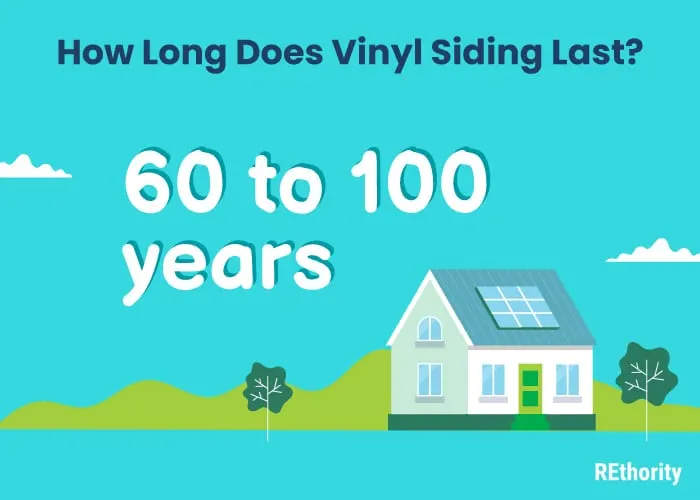
So, how long does vinyl siding last? The short answer is that vinyl siding lasts anywhere from 60 to 100 years. But the length of time vinyl siding lasts has a lot to do with how well it’s maintained. If you don’t bother to clean or make small repairs to it over the years, your vinyl siding will last about 60 years.
But if you use a vinyl siding cleaner regularly and maintain it by fixing small issues along the way, you can extend its lifespan even more.
With regular maintenance, vinyl siding can last up to 100 years without needing to be replaced. However, keep in mind that most manufacturers only offer a maximum of a 50-year warranty.
By comparison, other types of siding include:
- Wood siding: 20 years to 40 years, with painting and staining every few years
- Aluminum siding: Up to 40 years
- Fiber cement siding (like James Hardie Hardie Board): up to 100 years
- Stucco siding: Up to 100 years, but requires a lot of maintenance and upkeep
- Steel siding: About 40+ years
- Brick siding: 100+ years
- Stone siding: 20 to 75 years
Why Does Vinyl Siding Last So Long?
Vinyl siding lasts for a long time compared to other types of siding because it’s moisture-resistant, easy to clean and maintain, and extremely durable thanks to a dense foam insulation layer.
Simple Maintenance
Easy maintenance is one reason vinyl siding lasts so long. As long as it is properly installed, you don’t have to do much to keep it in great condition for decades.
A thorough cleaning every two years (or more often if you notice mold or mildew beginning to grow on it) is enough to keep it in top condition.
Unlike wood siding, which may need to be repainted or stained every few years and have planks replaced as they rot, vinyl siding has the color baked right into the material.
This means it keeps its color without needing to be painted, stained, or replaced. It’s an inorganic material, so it’s more resistant to the elements.
Moisture Resistance
Moisture resistance is another property that helps vinyl siding last for up to 100 years. Vinyl is a type of plastic that doesn’t allow water to penetrate through.
As long as your siding is installed correctly without channels or openings where water can find its way in, it will keep moisture out and protect your home’s structure.
Moisture is the enemy of wood. It seeps in, causes rot, expands and warps wood, makes conditions inviting for bugs and pests, and creates an opportunity for mold to grow.
When vinyl siding is installed over your home’s wooden frame, water just rolls off the moisture-resistant vinyl siding. It can’t penetrate unless the siding is improperly installed.
That means no rot, no expansion and warping, and no open invitations to bugs, pests, and mold.
Enhanced Durability
Vinyl siding can take a lot of abuse. Vinyl siding panels are made to stand up to impact, last for several decades, and move a little to prevent cracking and buckling.
This helps prevent damage when natural settling or temperature changes occur. Vinyl siding has a layer of foam insulation on the backside of each panel. This insulation serves a dual purpose.
It insulates the siding to help your home be more energy efficient (trapping heat and cool air inside). It also provides a dense protective layer for the panels that prevents cracking and denting.
Most Common Vinyl Siding Problems
While vinyl siding is the best all-around siding option in terms of durability, affordability, and ease of maintenance, it’s not without its problems.
Homeowners with vinyl siding typically report a few common problems. It’s important to know about these potential problems with vinyl siding if you plan to have it installed.
Below are the most common vinyl siding problems, along with the symptoms you may notice first.
Improper Installation
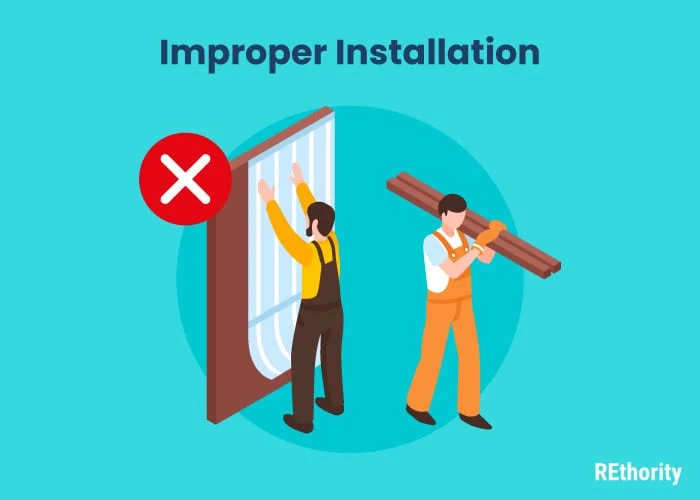
Symptoms: Warped, buckled, bulging, or wavy vinyl panels; gaps between panels; exposed nails; visible seams between panels; mold or water damage
Vinyl siding that isn’t properly installed is open to a range of problems down the road. Be careful with this one, too. Many discount contractors cut corners during installation.
If panels are hung too tightly or without enough room to naturally expand and contract in response to temperature changes, it won’t be long before problems become evident.
Improperly installed vinyl will crack, bend, ripple, bulge, or buckle in response to its inability to naturally expand and contract. It can also allow moisture to find its way in and cause mold issues and structural damage.
Typically, moisture issues occur when an installer has not installed the right flashing around the edges of doors and windows.
Settling and Movement
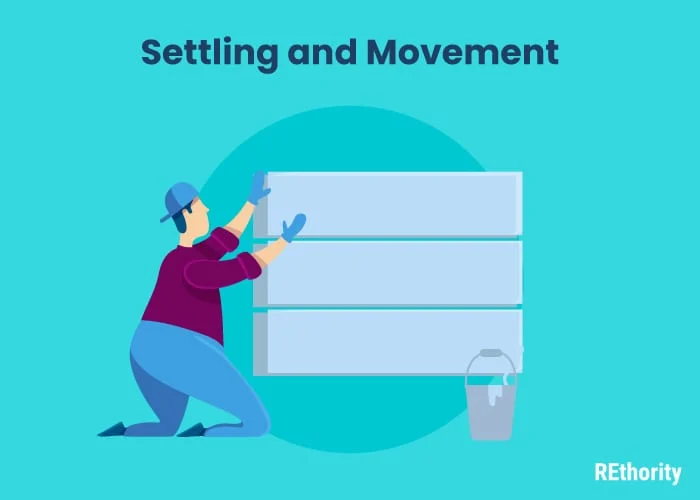
Symptoms: Bulging, wavy, or buckling vinyl panels; cracked panels in extreme cases
Vinyl siding can show signs of damage if the structure it’s installed on moves or settles noticeably.
Vinyl panels are attached to the structure underneath, so if the house settles, shifts, or even rots away in parts, the vinyl panels on the outside will show that damage.
They can bulge, bend, buckle entirely, or crack when the structure underneath has moved.
For this reason, if you see wavy, cracked, or buckling vinyl panels, you should have a professional inspect your home to make sure there are no serious structural issues underneath.
Insect and Impact Damage
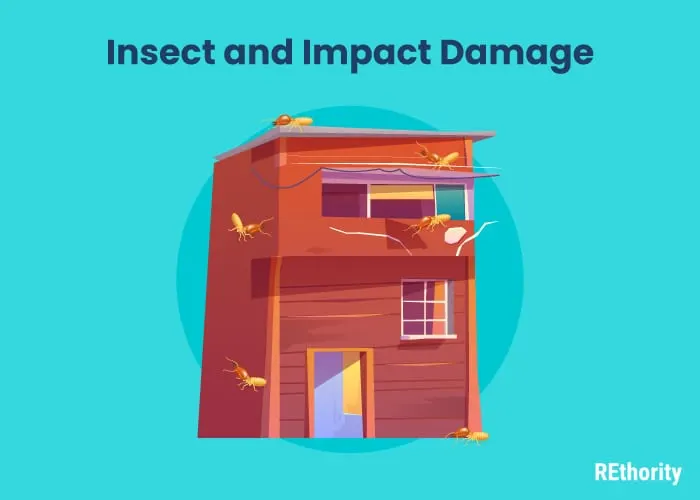
Symptoms: Warped, buckling, or wavy vinyl panels; chips or cracks in vinyl panels; loose, bulging panels or other signs of insect colonization
Vinyl siding can stand up to many types of damage, but insects and direct impacts can hurt it. Vinyl siding will reflect any damage from termites and boring insects that damage the structure underneath.
Any object that hits your home can potentially damage vinyl siding, from hail to rocks that are thrown by a lawnmower.
These issues are simple enough to fix but should be taken care of quickly to avoid moisture entering the hole and causing damage underneath.
Heat Damage
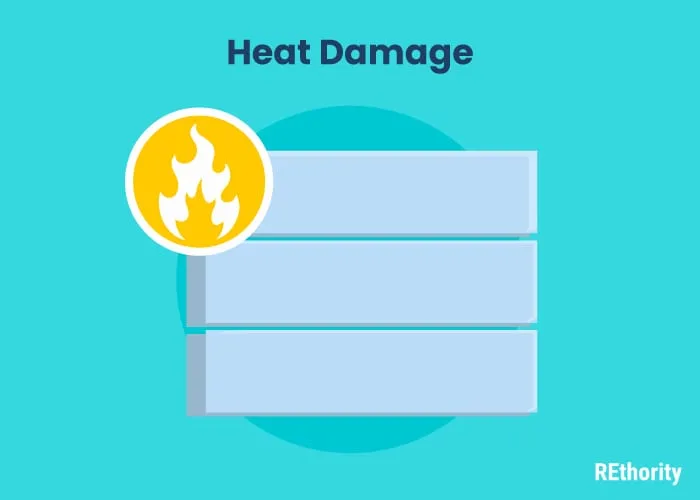
Symptoms: Melted or misshapen vinyl panels; buckling, rippled/wavy, or loose vinyl panels
Heat can damage vinyl siding, especially intense heat that is concentrated in one area. While a hot day won’t hurt vinyl siding, heat from a grill too close to the house or from sunlight being reflected from a nearby window will.
Intense heat can actually melt vinyl siding. Keeping heat sources away from the house and planting shrubs or trees that block reflected sunlight from nearby windows can prevent these problems from occurring.
How to Maintain Vinyl Siding
Vinyl siding is known for being low-maintenance and easy to take care of, but if you want it to last as long as possible (up to 100 years), you should take steps to keep it in good condition.
Cleaning Vinyl Siding

Vinyl siding should be thoroughly cleaned at least every two years. There are a few ways you can clean vinyl siding and a few different vinyl siding cleaner solutions you can use.
Tools Needed
- Soft cloth
- Soft-bristled brush with long handle
- Garden hose
- Bucket
- Vinyl siding cleaner solution of choice
To clean vinyl siding, gather the items above and choose the vinyl siding cleaner solution you want to use. Here are a few options.
Vinyl Siding Cleaner Solutions
- White vinegar (3 parts) + water (7 parts) = all-purpose cleaning solution
- Powdered detergent (1/3 C.) + powdered cleaner like Comet (2/3 C.) + laundry bleach (1 qt.) + water (1 gal.) = Strongest cleaning solution
- Water (1 gal.) + oxygen bleach (1 C.) = Cleaning solution that won’t hurt plants
- Household cleaners (Fantastik, Windex, etc.) = Cleaner for small, stubborn stains
- NEVER use undiluted bleach, acetone or nail polish remover, furniture polish, liquid grease remover, or highly abrasive scrubbers to clean vinyl siding
Fill a bucket with the cleaning solution of your choice. Connect your garden hose and keep it handy. Dip the soft cloth into the solution (wear gloves to protect your hands) and start from the bottom to avoid creating streaks of dirt.
Use circular motions to scrub the vinyl with the cloth. Rinse the cleaning solution residue off with the garden hose as you work. Don’t allow the cleaning solution to dry on the vinyl.
Switch to the long-handled brush when it becomes difficult to reach or use the brush for the entire job. When you’re finished, rinse the entire wall again with the garden hose to ensure all residue is removed.
Pressure Washing Vinyl Siding
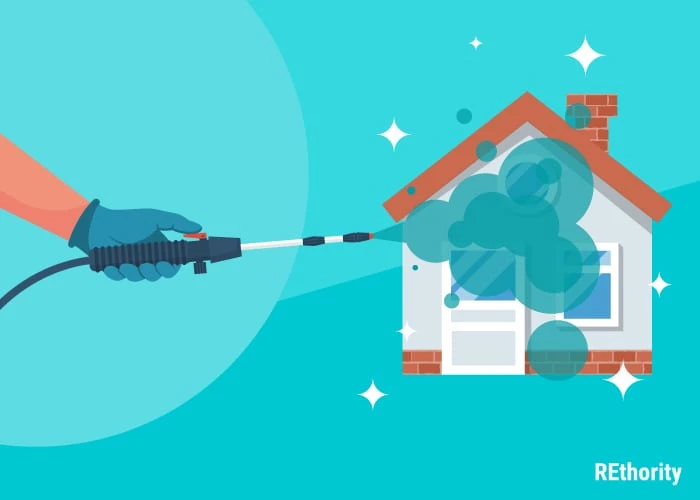
Many people want to pressure wash vinyl siding to speed up the job and ensure stubborn stains are blasted away.
You may be able to get away with pressure-washing vinyl siding, but vinyl siding manufacturers do not recommend it.
The high pressure can damage the siding or force water into small openings or holes you may not see. Don’t pressure-wash your vinyl siding if you want to keep it in great condition.
Vinyl siding lasts longer when it is gently cleaned by hand with a soft cloth or soft-bristled brush.
Other Ways to Make Vinyl Siding Last Longer
- If holes, cracks, or damaged areas appear, have them fixed immediately. Any damage to vinyl siding only creates an opportunity for water, mold, and even insects to create further damage.
- Plant trees and shrubs around areas of your home that get full sun exposure to prevent the vinyl siding from fading.
- Avoid pointing a sprinkler in a direction that will regularly hit vinyl siding, as this wears it down and can create hard water or rust stains that are difficult to remove.
- Remove rocks, sticks, and other debris from your lawn before mowing. These objects can be slung out by the lawn mower’s blades and create holes or cracks in vinyl siding.
- Clean any mold or mildew off the vinyl siding as it appears and spot-treat any stains beginning to form.
- If you decide to paint vinyl siding (if it’s faded or you want a new color), use a paint specifically designed for vinyl siding. Check first with your siding manufacturer, as painting siding can void some warranties.
So, How Long Does Vinyl Siding Last?
So, how long does vinyl siding last? It can last up to 100 years if you take the time and care to properly maintain it.
Make note of the maintenance tips above, and don’t forget to give it a good cleaning every other year.
Be watchful for any signs of damage or symptoms that might indicate underlying damage. This will ensure you keep your vinyl in top condition and make it last as long as possible.
Of all the types of siding available for homes, vinyl siding is a favorite choice because it is affordable, durable, and long-lasting.
With a little care and minimal upkeep, you can enjoy your vinyl siding knowing that you’ll never need to replace it.

